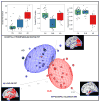Molecular imaging of Alzheimer disease pathology
- PMID: 24503555
- PMCID: PMC4259015
- DOI: 10.3174/ajnr.A3847
Molecular imaging of Alzheimer disease pathology
Abstract
Development of molecular imaging agents for fibrillar β-amyloid positron-emission tomography during the past decade has brought molecular imaging of Alzheimer disease pathology into the spotlight. Large cohort studies with longitudinal follow-up in cognitively normal individuals and patients with mild cognitive impairment and Alzheimer disease indicate that β-amyloid deposition can be detected many years before the onset of symptoms with molecular imaging, and its progression can be followed longitudinally. The utility of β-amyloid PET in the differential diagnosis of Alzheimer disease is greatest when there is no pathologic overlap between 2 dementia syndromes, such as in frontotemporal lobar degeneration and Alzheimer disease. However β-amyloid PET alone may be insufficient in distinguishing dementia syndromes that commonly have overlapping β-amyloid pathology, such as dementia with Lewy bodies and vascular dementia, which represent the 2 most common dementia pathologies after Alzheimer disease. The role of molecular imaging in Alzheimer disease clinical trials is growing rapidly, especially in an era when preventive interventions are designed to eradicate the pathology targeted by molecular imaging agents.
© 2014 by American Journal of Neuroradiology.
Figures




Similar articles
-
PET imaging of brain amyloid in dementia: a review.Int J Geriatr Psychiatry. 2011 Oct;26(10):991-9. doi: 10.1002/gps.2640. Epub 2010 Dec 28. Int J Geriatr Psychiatry. 2011. PMID: 21905095 Review.
-
Molecular imaging of dementia.Psychogeriatrics. 2012 Jun;12(2):106-14. doi: 10.1111/j.1479-8301.2012.00409.x. Psychogeriatrics. 2012. PMID: 22712644 Review.
-
Utility of Plasma Neurofilament Light in the 1Florida Alzheimer's Disease Research Center (ADRC).J Alzheimers Dis. 2021;79(1):59-70. doi: 10.3233/JAD-200901. J Alzheimers Dis. 2021. PMID: 33216030 Free PMC article.
-
Clinical and imaging correlates of amyloid deposition in dementia with Lewy bodies.Mov Disord. 2018 Jul;33(7):1130-1138. doi: 10.1002/mds.27403. Epub 2018 Apr 19. Mov Disord. 2018. PMID: 29672930 Free PMC article.
-
Multimodal PET Imaging of Amyloid and Tau Pathology in Alzheimer Disease and Non-Alzheimer Disease Dementias.PET Clin. 2017 Jul;12(3):351-359. doi: 10.1016/j.cpet.2017.02.005. Epub 2017 Apr 18. PET Clin. 2017. PMID: 28576172 Free PMC article. Review.
Cited by
-
The overlap between vascular disease and Alzheimer's disease--lessons from pathology.BMC Med. 2014 Nov 11;12:206. doi: 10.1186/s12916-014-0206-2. BMC Med. 2014. PMID: 25385447 Free PMC article. Review.
-
Tetrameric Transthyretin as a Protective Factor Against Alzheimer's Disease.Mol Neurobiol. 2025 Mar;62(3):2945-2954. doi: 10.1007/s12035-024-04442-8. Epub 2024 Aug 27. Mol Neurobiol. 2025. PMID: 39192044 Free PMC article. Review.
-
Dantrolene, a treatment for Alzheimer disease?Alzheimer Dis Assoc Disord. 2015 Jan-Mar;29(1):1-5. doi: 10.1097/WAD.0000000000000076. Alzheimer Dis Assoc Disord. 2015. PMID: 25551862 Free PMC article. Review.
-
Light on Alzheimer's disease: from basic insights to preclinical studies.Front Aging Neurosci. 2024 Mar 18;16:1363458. doi: 10.3389/fnagi.2024.1363458. eCollection 2024. Front Aging Neurosci. 2024. PMID: 38566826 Free PMC article. Review.
-
Brain PET in the diagnosis of Alzheimer's disease.Clin Nucl Med. 2014 Oct;39(10):e413-22; quiz e423-6. doi: 10.1097/RLU.0000000000000547. Clin Nucl Med. 2014. PMID: 25199063 Free PMC article. Review.
References
-
- Klunk WE, Engler H, Nordberg A, et al. Imaging brain amyloid in Alzheimer’s disease with Pittsburgh Compound-B. Ann Neurol. 2004;55:306–319. - PubMed
-
- Pike KE, Ellis KA, Villemagne VL, et al. Cognition and beta-amyloid in preclinical Alzheimer’s disease: data from the AIBL study. Neuropsychologia. 2011;49:2384–2390. - PubMed
Publication types
MeSH terms
Substances
Grants and funding
LinkOut - more resources
Full Text Sources
Other Literature Sources
Medical
Miscellaneous
